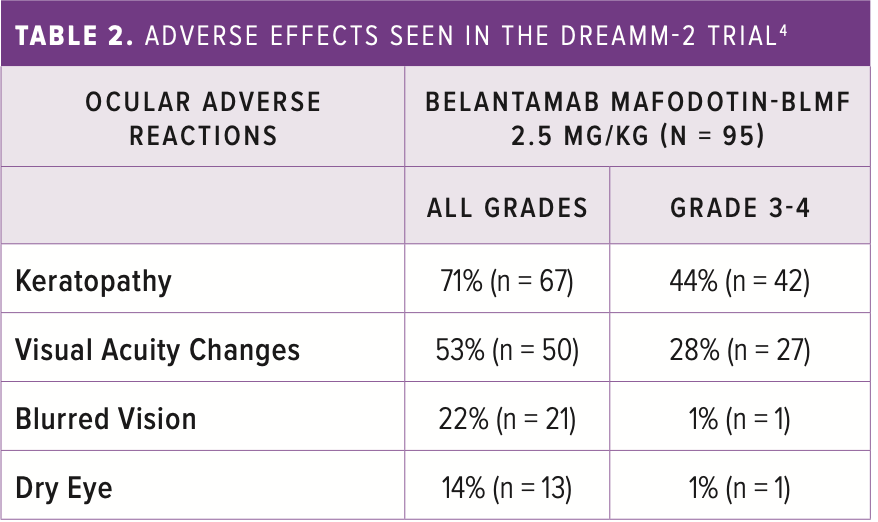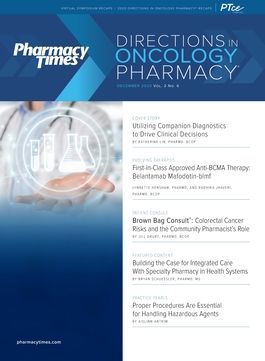Publication
Article
Pharmacy Practice in Focus: Oncology
First-in-Class Approved Anti-BCMA Therapy: Belantamab Mafodotin-blmf
Belantamab mafodotin-blmf (Blenrep; GlaxoSmithKline) is the first in its class anti-BCMA therapy to gain FDA approval.
Multiple myeloma is an incurable malignant neoplasm of the plasma cells that accumulate in a patient’s bone marrow. When newly diagnosed, multiple myeloma is typically sensitive to various cytotoxic drugs with durable response rates. However, most patients will ultimately relapse and are likely to develop refractory disease. Consequently, patients inevitably develop resistance to our current standard-of-care therapy options such as proteasome inhibiters, immunomodulatory agents, and anti- CD38 monoclonal antibodies. Even with recent significant improvements in treatment options for patients with relapsed and refractory multiple myeloma (R/RMM), the utility for new targeted disease pathways is necessary.1,2
FDA Approval
Belantamab mafodotin-blmf (Blenrep; GlaxoSmithKline) is the first in its class anti-BCMA therapy to gain FDA approval. Belantamab mafodotin-blmf is indicated for treatment of adults with relapsed or refractory multiple myeloma who have received at least 4 prior thera- pies including an anti-CD38 monoclonal antibody, a proteasome inhibitor, and an immunomodulatory agent. This indication was approved by the FDA on August 5, 2020, under an accelerated approval based on the response rate. Continued approval may be contingent upon verification of clinical benefit in confirmatory trials.3
The approval of belantamab mafodotin-blmf is based on the results of the DREAMM-2 clinical trial (NCT03525678), which was an open- label multicenter study (Table 1 ). Eligible patients had R/RMM with disease progression on 3 or more lines of therapy, which included immunomodula- tory drugs, proteasome inhibitors, and an anti-CD38 monoclonal antibody. Patients in this study were heavily pretreated, with 50% of participants having received 7 previous lines of therapy.
Patients included in the study had an Eastern Cooperative Oncology Group (ECOG) performance status of 0-2. Patients were randomized (1:1) to receive either 2.5 mg/kg dosing (n = 97) or 3.4 mg/kg dosing (n = 99), once every 3 weeks until disease progression or unacceptable toxicity. The median number of treatment cycles was 3 in each arm. The 2.5 mg/kg dose was selected based on the more favorable safety profile with fewer serious adverse events (40% vs 47%),less need for dose reductions (29% vs 41%), and fewer interruptions or delays to therapy (54% vs 62%).4
For the primary analysis, the median follow-up was 6.3 months as of June 21, 2019. Secondary end points also looked at progression-free survival (PFS), and at the time of the primary analysis median PFS was 2.9 months. Final results of overall survival (OS) are not available; however, at the time of primary analysis, the 6-month OS rate was 72% (95% CI, 62, 80%).4
Mechanism of Action
Belantamab mafodotin-blmf is an antibody-drug conjugate (ADC). The antibody component is an afucosylated IgG1 directed against B-cell maturation antigen (BCMA), a protein expressed on normal B lymphocytes and multiple myeloma cells. The small molecule component is MMAF, a microtubule inhibitor. Upon binding to BCMA, belantamab mafodotin-blmf is internalized, followed by release of MMAF via proteolytic cleavage. The released MMAF intracellularly disrupts the microtubule network, leading to cell cycle arrest and apoptosis.3
Belantamab mafodotin-blmf has antitumor activity in multiple myeloma cells and mediated killing of tumor cells through MMAF-induced apoptosis, as well as by tumor cell lysis through antibody-dependent cellular cytotoxicity (ADCC), and antibody-dependent cellular phagocytosis (ADCP).3
Dosage and Administration
Belantamab mafodotin-blmf is supplied as a 100-mg single-dose vial containing a white to yellow lyophilized powder for reconstitution and further dilution. Vials should be stored in the refrigerator at 36 °F to 46 °F. The dose of belantamab mafodotin-blmf is 2.5 mg/kg of actual body weight given as an intravenous infusion over approximately 30 minutes, once every 3 weeks until disease progression or unacceptable toxicity. Dose reduction to 1.9 mg/kg once every 3 weeks is warranted based on severity of adverse reactions. In patients unable to tolerate 1.9 mg/kg, the medication should be discontinued.3,4
Warnings and Precautions
Belantamab mafodotin-blmf has a black box warning because of ocular toxicity and is available through a restricted program under a Risk Evaluation and Mitigation Strategy (REMS). Prescribers must be certified with the program and complete the REMS training, the health care facility must be certified to order and dispense, and patients must be enrolled and adhere to monitoring. The monitoring includes eye exams at baseline, prior to each dose, and promptly for any worsening symptoms. The eye exam must also be within 1 week after the last treat- ment and 2 weeks prior to the next dose.4
In the DREAMM-2 trial, the most common adverse effect was keratopathy, based on corneal exam find- ings (Table 24). It is important to note that patients with corneal epithelial disease, except mild punctate keratopathy at baseline, were excluded from the trial.4
At the start of treatment, patients should be advised to start using preservative-free lubricant eye drops at least 4 times a day and continue until the end of treatment. The ocular toxicities were managed with dose modifications either as dose reductions, interruptions, or permanent discontinuation.3
Adverse reactions that required dose reductions occurred in 29% of patients. Dose reductions occurred in greater than 3% of patients with adverse reactions that included keratopathy (23%) and thrombocytopenia (5%). Other adverse effects consisted of infusion- related reactions, gastrointestinal disorders (nausea, constipation, and diarrhea), pyrexia, and fatigue.4

Future Direction
Belantamab mafodotin-blmf is the first approved anti- BCMA agent.1 The manufacturer is conducting a larger clinical trial (DREAMM-3) that is expected to have its results by 2022. DREAMM-3 (NCT04162210) is a randomized, phase 3, confirmatory study comparing belantamab mafodotin-blmf with a pomalidomide/ dexamethasone combination therapy in patients with R/RMM who have previously received 2 or more lines of therapy. The primary end point will look at overall survival. The manufacturer also plans to evaluate belantamab mafodotin-blmf in earlier lines of therapy in several other upcoming studies.1
Other anti-BCMA agents are undergoing investigation. There are 3 common treatment modalities for targeting BCMA, the first being antibody-drug conjugates such as belantamab mafodotin-blmf, bispecific T-cell engager (BiTE) immune-oncology therapies, and chimeric antigen receptor (CAR) modified T-cell therapy.5 There are no ongoing clinical trials comparing belantamab mafodotin-blmf with other anti-BCMA therapies.
AMG 420 is a BiTE agent undergoing investigation in a phase 1 clinical trial for monotherapy in R/RMM. The study’s estimated completion date is 2025.
One limitation foreseen with AMG-420 is the short half-life of the drug resulting in the necessity for a prolonged (28-day) continuous infusion.6
Anti-BCMA CAR T therapy has been examined in various phase I/II studies and demonstrated promising results in patients with R/RMM. In updated results from the CARTITUDE-1 (NCT03548207) study, lower dose levels of CAR T showed 26 of 29 (90%) patients had PFS at median 9-month follow-up. This trial is ongoing and projected to complete in April 2022.8
In the last decade, we have had multiple advances in the treatment of multiple myeloma. As more data arise from upcoming clinical trials using alternative treatment pathways, a shift in our treatment approach will continue to develop.
LYNNETTE HENSHAW, PHARMD, is a PGY-2 oncology pharmacy resident at Boston Medical Center in Boston, Massachusetts.RADHIKA JHAVERI PHARMD, BCOP, is a hematology/oncology pharmacy managerand PGY2 oncology residency program director at Boston Medical Center in Boston, Massachusetts.
REFERENCES
- Trudel S, Lendvai N, Popat R, et al. Antibody—drug conjugate, GSK2857916, in relapsed/refractory multiple myeloma: an update on safety and efficacy from dose expansion phase I study. Blood Cancer J. 2019;9(4):37. doi:10.1038/s41408-019-0196-6
- Uckun FM, Qazi S, Demirer T, Champlin RE. Contemporary patient-tailored treatment strategies against high risk and relapsed or refractory multiple myeloma. The Lancet. 2019;39(Jan):612-620. doi:10.1016/j.ebiom.2018.12.004
- Blenrep. Package insert. GlaxoSmithKline; 2020.
- Lonial S, Lee HC, Badros A, et al. Belantamab mafodotin for relapsed or refractory multiple myeloma (DREAMM—2): a two–arm, randomised, open–label, phase 2 study. Lancet Oncol. 2020;21(2):207-221. doi:10.1016/S1470-2045(19)30788-0
- Shah N, Chari A, Scott E, Mezzi K, Usmani SZ. B-cell maturation antigen (BCMA) in multiple myeloma: rationale for targeting and current therapeutic approaches. Leukemia. 2020;34(4):985-1005. doi:10.1038/s41375-020-0734-z
- Topp MS, Duell J, Zugmaier G, et al. Evaluation of AMG 420, an anti-BCMA bispecific T-cell engager (BiTE) immunotherapy, in R/R multiple myeloma (MM) patients: Updated results of a first-in-human (FIH) phase I dose escalation study. Abstract presented at: 2019 American Society of Clinical Oncology (ASCO) Annual Meeting; May 31-June 4, 2019; Chicago, IL.
- Weisel K, Hopkins TG, Fecteau D, et al. Dreamm-3: a phase 3, open-label, randomized study to evaluate the efficacy and safety of belantamab mafodotin (GSK2857916) monotherapy compared with pomalidomide plus low-dose dexamethasone (Pom/Dex) in participants with relapsed/refractory multiple myeloma (RRMM). Blood. 2019;134(suppl 1):1900. https://doi.org/10.1182/blood-2019-129893
- A study of JNJ-68284528, a chimeric antigen receptor T-cell (CAR-T) therapy directed against B-cell maturation antigen (BCMA) in participants with relapsed or refractory multiple myeloma.(CARTITUDE-1). ClinicalTrials.gov. Updated October 9, 2020 . https://clinicaltrials.gov/ct2/show/NCT03548207

Newsletter
Stay informed on drug updates, treatment guidelines, and pharmacy practice trends—subscribe to Pharmacy Times for weekly clinical insights.




